JQ Magazine: North American Alumni Regional Conference Advances JETAA Initiative
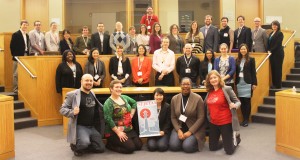
Delegates to the 2014 JETAA Regional Conference at the Edwin O. Reischauer Institute of Japanese Studies at Harvard University, Jan. 2014. (Courtesy of Tim Ogino)
By Tim Ogino (Akita-ken, 2011-13) for JQ magazine. Tim returned from Japan last summer and immediately became involved in NEJETAA as communications coordinator/webmaster. After spending two wonderful years in Tohoku, he returned to Boston to attend graduate school and is excited to remain involved with the Japanese community, looking forward to the day he can return to the land of festivals, kiritampo, and karaoke.
With New Year’s goals and resolutions firmly prepared, 34 JETAA delegates from 15 chapters across North America gathered for the 2014 JETAA Regional Conference at the Edwin O. Reischauer Institute of Japanese Studies at Harvard University in Cambridge, MA from Jan. 10-12 to discuss ways to improve their JETAA chapters. The New England JETAA chapter played host to this year’s conference and organized a series of discussions, workshops, and seminars under the theme of “Membership Management.”
The week preceding the conference was filled with anticipation about not only the content of the seminars and workshops, but also the weather in Boston. Stories about the week’s now infamous “polar-vortex” surely were intimidating to JET Alumni from warmer climates. Luckily, the temperatures recovered just in time for a comfortable and productive weekend for all in attendance.
The conference began on Friday night with a welcome reception graciously hosted by the Consul General of Japan in Boston, Akira Muto, which featured special guests Museum of Fine Arts Curator Dr. Anne Nishimura Morse and founding JETAA member Professor Ian Condry (Miyagi-ken, 1988-89) of MIT. Their kind remarks emphasized the importance of membership in JETAA as well as the presence of Japanese culture and art in America, setting an ambitious tone for the rest of the weekend.
JQ Magazine: Film Review—Hirokazu Kore-eda’s ‘Like Father, Like Son’
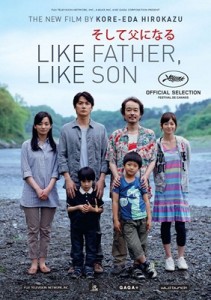
“As in his other films, Kore-eda’s action unfolds in minute detail and slowly evolving scenes. His static camera and well-balanced visual frame reference Ozu, another director concerned with Japan’s modernization and the traditional family.” (© 2013 FUJI TELEVISION NETWORK, INC.AMUSE INC.GAGA CORPORATION. All rights reserved.)
By Lyle Sylvander (Yokohama-shi, 2001-02) for JQ magazine. Lyle has completed a master’s program at the School of International and Public Affairs at Columbia University and has been writing for the JET Alumni Association of New York since 2004. He is also the goalkeeper for FC Japan, a New York City-based soccer team.
The winner of the Jury Prize at the 2013 Cannes Film Festival, Hirokazu Kore-eda’s newest film, Like Father, Like Son, features a stronger narrative arc and story than his previous films, which include the metaphysically philosophical After Life and the naturalistic Ozu-like Nobody Knows. In fact, the film’s plot reads like a Hollywood high-concept pitch: two families discover that their children are not their own due to a switch at birth. Developing a “nature vs. nurture”-type approach to the subject, Kore-eda gives the families different socioeconomic backgrounds.
Ryota Nonomiya (Masaharu Fukuyama) is a high-achieving architect who lives in a modern Tokyo high-rise apartment with his wife Midori and their six-year-old son Keita (Keita Ninomiya). The other father, Yudai Saiki (Lily Franky), is a working class shopkeeper who lives on the outskirts of the city in a nondescript housing block with his wife Yukari (Yoko Maki) and the young Ryusei (Hwang Sho-gen). By presenting these two disparate backgrounds, Kore-eda examines the nature of father-son relationships and familial influence in modern Japan.
Much of the film’s action concerns the responses to the shocking new information. Do the families try and “switch” the children again so that the original wrong can be corrected? Now that they are inseparably involved in each others’ lives, do they try and raise the children together? Or do they simply carry on as before, complicit in their knowledge that neither child is living with his biological parents? Kore-eda examines each of these scenarios as the characters try to confront a situation that life has not prepared them for.
JQ Magazine: Tohoku Projects—The TOMODACHI Initiative
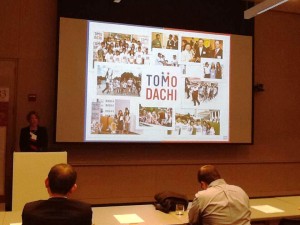
Suzanne Basalla, left, presents The TOMODACHI Generation: Investing in the NEXT Generation of U.S – Japan Relations, Chicago, Oct. 11, 2013. (Sheila Burt)
By Sheila Burt (Toyama-ken, 2010-12) for JQ magazine. As part of an occasional series, Sheila is profiling individuals who are or were in some way involved with rebuilding efforts in the Tohoku region. Her first post was on the writing project 3,000 Letters to Japan. After JET, Burt spent an additional year in Japan working at a private school and translation company. She recently returned to the Chicago area. Read more of her reporting at her blog, Stories from the Inaka.
Having been posted in Tokyo during the disastrous March 11 earthquake and tsunami of 2011, diplomat Suzanne Basalla saw firsthand how quickly Japan changed in a matter of seconds.
As senior advisor to former Ambassador John V. Roos in the Embassy of the United States in Tokyo, Basalla had been living in Japan since March 2010, advising Roos on several economic and foreign policy matters. A few months after 3/11, Basalla visited Tohoku and started thinking of ways to encourage redevelopment in the stricken area, “trying to do what we [could] to create hope and support,” she recalled. Although her post with the embassy ended in March 2012, she realized she wasn’t ready to go back to the Pentagon.
Instead, Basalla and a team of others pooled their efforts to create the TOMODACHI Initiative, a public-private partnership established in the wake of 3/11 with the U.S.-Japan Council in Washington. TOMODACHI helps coordinate educational, business and cultural exchange programs for Japanese youth, particularly students in Tohoku, where development opportunities are still few and far between. Presenting at a Japan American Society of Chicago event last October, Basalla referred to TOMODACHI as “an incredibly important initiative…with a path-breaking paradigm.”
“Part of leadership is getting to know yourself,” said Basalla, who now serves as executive vice president of the U.S.-Japan Council. “TOMODACHI’s initiative is to inspire and empower young Japanese and Americans by giving them experience, skills and confidence to achieve their dreams and contribute to a better world.”
JQ Magazine: Manga Review — ‘Showa 1926-1939: A History of Japan’

“If you enjoy or are interested in manga, history and yokai, or if you appreciate excellent works such as Barefoot Gen and Maus, then Showa 1926-1939: A History of Japan and the rest of the series is a must-read.” (Drawn and Quarterly)
By Julio Perez Jr. (Kyoto-shi, 2011-13) for JQ magazine. A bibliophile, writer, translator, and graduate from Columbia University, Julio is currently seeking opportunities with publications in New York. You can follow his enthusiasm for Japan, literature, and board gaming on Twitter @brittlejules.
Shigeru Mizuki is a world-famous manga artist and writer best known for his work on yokai, which deals with Japanese ghosts, monsters and supernatural stories. He is the creator of Ge Ge Ge no Kitaro, his most famous work about yokai, and he is also well known and respected in Japan for his autobiographical work about growing up and serving as as a soldier in World War II-era Japan. He created a well researched historical and autobiographical manga about the Showa period which received the Kodansha Manga Award in 1990 and is now being published in English by Drawn and Quarterly. The first of four volumes, Showa 1926-1939: A History of Japan, was translated by JET alum Zack Davisson (Nara-ken, 2001-04; Osaka-shi, 2004-06) and released last November. (For more on Davisson, read our exclusive JQ interview with him here.)
This illustrated history of Japan is praised for its accuracy in portraying the atrocities of the Japanese military during the Pacific War while also showing how the Japanese people themselves suffered on the home front. At 91 years old today, Mizuki has given us a complete and accurate account of an entire age that few alive today remember and that the rest never knew firsthand. The story is an important and valuable resource meant for generations of people who have not experienced the chaos of war and the despair of starvation. The manga is very much meant to educate the next generation of Japanese children about the controversial and darker parts of their history and to serve as a cautionary tale to remember in times of peace. It does not sugarcoat anything, and gives great insight into the tensions between Japan and China, North and South Korea, and other countries in Asia that persist today.
JQ Magazine: Hark! The Herald KFC
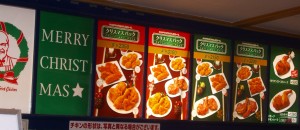
Good tidings we bring for you and your kin /
Good tidings for chicken and a happy new year. (Jarrad Skinner)
By Jarrad Skinner (Toyama-ken, 2007-11) for JQ magazine. Jarrad is an instructional designer for interactive online courses in the mental health field. Otherwise, he’s obsessed with game design, comedy, and hip-hop. After being born on Long Island, educated in Manhattan, and confused in Japan, he lives in Brooklyn. You can find him on the dance floor.
It’s Christmas Eve and KFC is out of chicken. This can’t be life. We didn’t make reservations, so we can’t have any chicken. It’s one thing to walk into KFC on Christmas Eve to get a bucket of greasy poultry parts, but it’s a whole other indignity to be told you can’t have any. Biscuits and sides will have to do.
As many of you probably already know, KFC pulled off some kind of unholy cross-cultural coup to convince a good portion of Japan that KFC and Christmas go together like peanut butter and jelly. Well, that is, if you’re American, PB&J go together naturally. And that’s really the point that I had to stubbornly learn again and again in Japan: nothing naturally goes with anything. We make it up as we go and then get used to our inventions. We become so used to them, we call them natural or traditional or don’t call them anything at all because we take them for granted like pizza with tuna fish topping.
If there’s one thing we take for granted more than readily available pairings of foods, it’s family. You might be a jackass today, but you expect family to be there tomorrow anyway. And if there’s one message that’s been drilled into our heads by the seasonal onslaught of holiday songs and shows, it’s “Go home to your family!” Every memory of every sitcom holiday special featuring some selfish oaf learning the lesson that the real present at Christmas is family reminds me that as the holidays approach in Japan I feel…unnatural.
JQ Magazine: The Steady Riser – A Conversation with Tokyo Musician Nelson Babin-Coy

“The Japanese market is a very unique market; it’s very closed. It is kind of frustrating when I try to introduce Western ideals in my music or introduce how I feel live music should be enjoyed at gigs or live venues. If you want to dance, dance. If you want to move, move.” (Lisa (paint with stars) www.paintwithstars.com)
By Sheila Burt (Toyama-ken, 20010-12) for JQ magazine. Sheila recently returned to America after living in Japan for three years (two years in Namerikawa with JET and one year at a private school in Ehime-ken). She is currently looking for a job and welcomes all leads. View more of her work at www.sheilaburt.com.
The first time Tokyo-based musician Nelson Babin-Coy visited Japan, he was a 15-year-old high school student from the suburbs of L.A. who knew next to nothing about Japan. Interested in learning more about Japanese music during his stay in Gunma Prefecture, he started listening to what other teenagers his age were into, including the idol group Morning Musume. Yet when he first heard one of the band’s songs, he cringed a bit. “I wasn’t disgusted, but I was like, ‘This is music in Japan?’,” he laughs.
Thankfully, his host sister introduced him to the Battle Royale theme song by Dragon Ash, and he was hooked. The two weeks Babin-Coy spent in Gunma were enough to give him a new dream to follow. He wanted to live in Japan, though he had yet to figure out the how and what to do.
“I love Japanese music and lyrics,” he says. “I think Japanese artists are more artistic in the way they form their stories.”
Now 28, Babin-Coy is a rising singer-songwriter who primarily sings in Japanese and works with several native artists trying to break into the Western market. He has toured the mainland three times with his band, nothing ever lasts (currently on hiatus).
JQ Magazine: JQ&A with Manga Translator Zack Davisson on Shigeru Mizuki
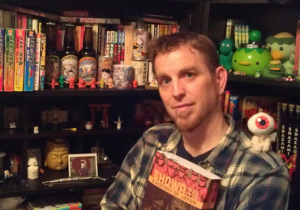
“All of JET is fond memories for me. I loved it. Kansai was the perfect area. Nara, Osaka, and Kyoto were all in easy reach so I had the best of everything. I lived in ancient and traditional Japan, but had wild and modern Japan nearby anytime I wanted. I did everything I could possibly do, went everywhere, tried everything—it changed my life.” (Courtesy of Zack Davisson)
By Julio Perez Jr. (Kyoto-shi, 2011-13) for JQ magazine. A bibliophile, writer, translator, and graduate from Columbia University, Julio is currently seeking opportunities with publications in New York. You can follow his enthusiasm for Japan, literature, and board gaming on Twitter @brittlejules.
A scholar, author and translator of Japanese folklore and ghost stories, Zack Davisson (Nara-ken, 2001-04; Osaka-shi, 2004-06) joined the JET Program in 2001 with some basic Japanese knowledge and a strong desire to learn much more. After spending five years on the program, he remained in Japan to acquire a master’s degree in Japanese studies while writing freelance and translating for Osaka University.
The theme of Japanese ghosts running through Davisson’s writing and translation dovetails the interests of manga legend Shigeru Mizuki, who is famous for the classic series GeGeGe no Kitaro. Mizuki is equally well known in Japan for his autobiographical works about his experiences as a soldier during World War II. A great fan of Mizuki, Davisson now contributes to publisher Drawn and Quarterly’s English adaptations of Kitaro and is the translator of the first volume of Mizuki’s historical manga Showa 1926-1939: A History of Japan, released last month in North America.
In this exclusive, expansive interview, Davisson discusses his time on JET, the significance of Mizuki’s supernatural and historical works, and the unique methods and madness of manga translation.
How did you first become interested in learning the Japanese language, and how long have you been studying it? For aspiring translators who are still studying, do you have any advice about textbooks, programs, or techniques?
I actually became interested when I was about 10 years old and my mother took me to see Seven Samurai at a local art theater. I was hooked pretty early—if I you look at my class pictures from that time I am wearing ridiculous Japan t-shirts. I took Japanese in high school when it was offered as a foreign language, but there were only four of us in the class, so it was cancelled—no one was interested in learning Japanese back then. This was the ’80s, so there was no “Cool Japan.” That pretty much ended my language studies for a while.
Decades later when I went on JET, I was useless language-wise. I thought I knew more Japanese than I did, but really just the set phrases and greetings. I was determined to leave JET functionally bilingual, so I just studied as hard as I could from day one, eventually getting my master’s degree in Japan.
My only real advice for people is to go to Japan, and talk and read and practice as much as humanly possible. There is no substitute for immersion and experience. I always say I learned more Japanese at my local bar, the 100 Club, than I did doing my MA. Talk, talk, talk. Read, read, read. Use Japanese as a living language, don’t just study it as an abstract. And, of course, marry a Japanese person. That’s a huge advantage!
When and where were you posted for JET? Could you talk a bit about your time there and what you remember fondly?
I started JET in…I think 2001. Crazy to think it was more than 10 years ago, because it doesn’t feel that way. I was unusual in that I was a 5-year JET that worked in two prefectures. I did three years in Nara and then two years in Osaka. I don’t know if they still allow you to do that. I was one of the first in my prefecture to get that contract extension, and even then there were only two of us allowed to do it.
As for fond memories…all of JET is fond memories for me. I loved it. Kansai was the perfect area. Nara, Osaka, and Kyoto were all in easy reach so I had the best of everything. I lived in ancient and traditional Japan, but had wild and modern Japan nearby anytime I wanted. I did everything I could possibly do, went everywhere, tried everything—it changed my life. And my career; I got started in writing and translating doing articles for my prefectural newsletter, then moved on to publishing magazine articles for Kansai Time Out and Japanzine. And now I have my Shigeru Mizuki translations out and my book, Yurei: The Japanese Ghost, coming next year. I owe all that to JET and the people I met on JET.
In what ways did you become involved in your community?
I wasn’t a big community person, other than I threw myself into every matsuri I could. I was fascinated with Shinto festivals, especially the big, loud, and dangerous ones. Anything fueled with alcohol and adrenaline. I did the Okayama Hadaka Matsuri four times and brought the magic sticks out twice. I carried this massive mikoshi in a little village in Nara every year. In Osaka, I carried these giant, flaming torches in the Taimatsu Matsuri for my town. I loved the primal nature of these matsuri, the physicality and closeness to the gods—it’s something we’ve completely lost in the U.S. In our quest for safety and comfort we’ve lost something intangible. Something Joseph Campbell would have recognized and appreciated.
Other than that, I was a regular at a local bar, the 100 Club in Osaka. A different kind of community, but that was another life changer. I’m still friends with my pals from the 100 Club and we even got matching tattoos. Not quite as sweet as volunteering at the local children’s eikaiwa, but there it is.
JQ Magazine: Book Review – ‘Life in Japan: The First Year’
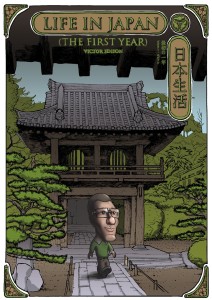
“Edison’s artistic talent captures Japan’s essence and his autobiographical account is honest and direct. JET Alumni will be able to follow his story and find many of their own experiences and thoughts represented within his work. From his first encounter ordering a hamburger to his dissatisfaction with being a glorified babysitter, his tone and pace keeps the reader hooked.” (Big Ugly Robot Publishing)
By Lana Kitcher (Yamanashi-ken, 2010-12) for JQ magazine. Lana is the business development associate for Bridges to Japan. To read more about Lana’s adventures in Japan and New York, visit her blog at Kitcher’s Café.
Victor Edison is a young man who remembers always having some Japanese influences present throughout his life. His family hosted a Japanese exchange student during his childhood, and he was fascinated by anime and manga from a young age. After graduation he found himself working a job he didn’t really want that wasn’t really going anywhere. A friend that was working in Japan at the time encouraged him to apply to be an English teacher and all he could respond to this was, “why not?”
Published by Nagoya-based Big Ugly Robot Press, Life in Japan: The First Year is a bilingual graphic novel written and drawn by Edison about his first year working for an English language school in Mie Prefecture. With little previous knowledge of the Japanese language or customs, he travels blindly to his new home armed only with his enthusiasm and determination to succeed, his ultimate goal to one day become a full-time artist.
His first choice was to work in Tokyo, simply because that was all he knew. After his interview with “Noba,” he soon learns that he has been offered a position in Mie, and accepts.
He starts work at an English conversation school located in a semi-rural area. While the majority of the clients were adults and young adults, the teachers often had to “teach” toddler classes as well. Because the school was located in a shopping mall, many parents would drop their kids off at the English school to fit in some uninterrupted shopping time. The teachers quickly learned that the child classes were thinly disguised babysitting sessions.
JQ Magazine: 2013 JETAA Oceania National Conference Spotlights Sister City Relationships

Hiromi Hakuta, assistant director of CLAIR Sydney, addresses alumni at the JETAA Oceania National Conference, Brisbane, Nov. 2013. (Courtesy of Hiromi Hakuta)
By Eden Law (Fukushima-ken, 2010-11). After the JET Programme more than fulfilled its promise of “an experience of a lifetime,” Eden returned to Sydney, Australia, where he joined the JETAA New South Wales chapter to take advantage of the network and connections available to undertake projects such as an uchiwa design competition for the Sydney Japan Festival. He also maintains the JETAANSW website and social media. Other than that, he’s a web designer and a poet, gentlemen and raconteur.
One of the best things about being a member of JETAA is the community, and over the weekend of 15-17 of November, the Oceania community of JETAA got together for our annual antipodean regional conference. For those of you up north who don’t know, JETAA Oceania comprises of five Australian chapters (the state chapters of Queensland, New South Wales, Canberra, the uber-chapter of South Australia-Victoria-Tasmania, Western Australia) and three New Zealand chapters (South Island, Auckland and Wellington). Representatives from Sydney’s CLAIR office (Tsuyoshi Ito, Hiromi Hakuta and Julien Ansart) attended as observers of the proceedings. This year, JETAA Queensland played host in Brisbane, the northern capital that looks to Asia and is close to the Gold Coast, a favoured destination for young Japanese looking for sun, surf and sand. Appropriately, we had our first lunch meet on Friday at MOS Burger, the famous Japanese fast food chain whose only non-Asian presence internationally is right in Brisbane.
JETAA Oceania was invited to attend the Welcome Back Reception for returning JETs at the Japanese Consul General’s home in Brisbane on the Friday night, a chance of course for us to network and hobnob with the cream of Brisbane’s Japanese cultural community. And after the reception finished (early, predictably), JETAA kicked on in town for a night out (hint: it’ll always involve karaoke—usually lots of obscure Japanese songs sung by that one quiet serious person who turns into a blurry, hip-thrusting maniac).
The first day of the conference began on Saturday, early (for some, too early) at our hotel and Laura Tasharofi, president of JETAA Qld, began proceedings by explaining the theme of this year: Australia-Japan sister-city relationships. As explained by Hakuta-san, of all countries, Japan has the most links in Oceania, with 108 sister city relationships in Australia and 44 in New Zealand. Therefore, the potential for JETAA to get involved is great, and the conference’s objective is to find ways to participate and be more prominent in our local communities. To start discussions and provide ideas and examples, two guest speakers, Ross Humphreys and Barry Hancock, were invited who are respected members of the Brisbane community and its influential sister city relationships.
JQ Magazine: JETAA USA Earthquake Relief Fund Aids Recovery
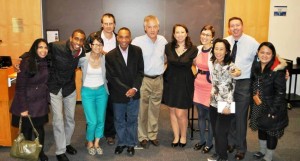
Taylor Anderson Memorial Fund founder Andy Anderson (center) with members of the JET Alumni Association of New York at Columbia University, Oct. 30, 2013. (Courtesy of JETAA New York)
By C-M Daeley (Saga-ken, 2008-2011) for JQ magazine. C-M is a poet, rap lyricist, and travel enthusiast currently working as an English teacher in Tokyo. For a look at some of his other writing, poetry and lyrics, check out his blog at http://spikedaeley.wordpress.com.
With today’s 24-hour global news cycle, it is sometimes difficult to keep even the most severe events in public memory. The Great East Japan Earthquake that struck on March 11, 2011 has not received much recent coverage in global news, but the issues faced by those still rebuilding remain monumental. Fortunately, there has been significant international aid from a number of sources, one of which is the JETAA USA Earthquake Relief Fund. This grant has raised almost USD $90,000 and has been used to provide seed funding to assist grassroots programs in areas severely impacted by the earthquake.
Due to the complex nature of fund allocation, this article will focus mainly on projects and programs directly supported through JETAA funds. However, it is significant to note that the Earthquake Relief Fund was only one of several avenues used to bring aid to the region and that, to date, roughly $500,000 has been raised through JET-affiliated groups and organizations worldwide. Jim Gannon (Ehime-Ken, 1992-94), current executive director at the Japan Center for International Exchange in New York, and Jessyca Livingston (Hokkaido, 2003-06), one of the three JETAA USA Country Representatives serving during the immediate aftermath and current JET Program coordinator at the Consulate-General of Japan in Denver, spoke about some of the initiatives the Earthquake Relief Fund has helped support.
“It is very difficult to give a concise yet comprehensive picture of what the JETAA funds have done,” Gannon explained. “The best way to describe it is that they have played a catalytic role in supporting some key projects in the early stage that have been supported by a range of others in more generous fashion once they proved their merits. JETAA cannot take full credit for all of the successes, but it did play an important role in getting things moving.” He also noted, “The real heroes are these incredible people from Tohoku who have championed these projects, the inspirational young people who have relocated to Tohoku to help operate them, and those who have been shuttling back and forth from Tokyo and elsewhere to help formulate and drive these initiatives.”
After a national discussion and several rounds of voting in each of JETAA USA’s 19 chapters, a final decision was made about how the fund should be allocated. “In the end, it was very obvious that chapters found it important to support education-related efforts in those areas most affected,” Livingston said.
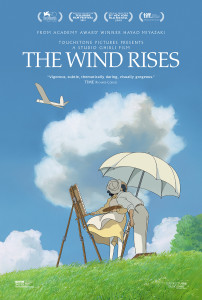
“The Wind Rises is a combination of everything that makes Studio Ghibli as we know it today. It also adds several new elements which make this film dynamic and, some say, controversial.” (Touchstone Pictures)
By Alexis Agliano Sanborn (Shimane-ken, 2009-11) for JQ magazine. Alexis is a graduate of Harvard University’s Regional Studies—East Asia (RSEA) program, and currently works as an executive assistant at Asia Society in New York City.
Written and directed by Hayao Miyazaki, The Wind Rises is like no Studio Ghibli movie I have ever seen. No. Wait. It’s like every Ghibli movie I have ever seen. You want fantasy? You got it. You want airships à la Castle in the Sky or Nausicaä of the Valley of the Wind? You got it. You want deliciously portrayed food? You want nostalgic scenery from bygone days of Tokyo or picturesque European towns? You got that, too. The Wind Rises is a combination of everything that makes Ghibli as we know it today. It also adds several new elements which make this film dynamic and, some say, controversial.
One of the most differentiating factors is that The Wind Rises is the only full-length feature to focus on an actual historical figure—Jiro Horikoshi, the designer of the Mitsubishi A5M, a fighter aircraft of World War II. Granted, Miyazaki used his artistic license to embellish the narrative—but he does that only to make things more beautiful and fantastical. (And that’s why we love Miyazaki, right?)
Watching The Wind Rises, you feel repeatedly—and indeed the entire plot more or less focuses on—Japan’s desperation to achieve modernity according to “Western standards.” But modernization was not a smooth road, and Miyazaki makes that message clear. Despite the beautiful veneer, the crux of this film lies in the frustration of a country and its people. Economic deflation, poverty, and limited resources repeatedly arise as roadblocks. (This may explain part of the reason for its amazing popularity in Japan. Frustrations, impatience and desperation exist within every generation.) Yet, as Jiro is reminded, even with setbacks and disappointments, one must live on and progress despite it all.
JQ Magazine: JQ&A with Marco Lienhard, Artistic Director of Taikoza

“I always seem to discover new things and different aspects of the music when teaching people from different backgrounds. When trying to explain some of the music, some things seem to come back to mind that were deep inside myself.” (Courtesy of Marco Lienhard)
By Rashaad Jorden (Yamagata-ken, 2008-10) for JQ magazine. A former head of the JETAA Philadelphia Sub-Chapter, Rashaad currently studies responsible tourism management at Leeds Metropolitan University. For more on his life in the UK and enthusiasm for taiko drumming, visit his blog at www.gettingpounded.wordpress.com.
Marco Lienhard has been involved in Japanese music for more than 30 years, first as a member of Ondekoza and then as the artistic director of Taikoza. When building his reputation as a professional taiko player in Japan, Lienhard also mastered the shakuhachi, eventually peforming at four major shakuhachi festivals around the world. He is also the founder of shakuhachi and koto group the East Winds Ensemble.
Lienhard has also released several albums, and his music can he heard on the score of the Nintendo Wii games Red Steel and Red Steel 2. His music has also appeared on ESPN, the History Channel and PBS. In this exclusive interview, Marco discusses his efforts to expand taiko’s global audience, the biggest influences in his career, and his personal highlights among 6,000 performances (and counting).
Where are you originally from and what sparked your interest in Japan and its traditional music?
I originally came from Switzerland, the French part. I went to Japan when I was 18 on some exchange program. I was very interested to go to Japan, but did not know much about it. Once there, I discovered the shakuhachi and the taiko. I had been studying the flute, but that sound of the shakuhachi just was amazing and I decided to study the instrument and master it. The first time I heard it was when I saw Ondekoza. There was taiko, too, and that was just so exciting to see. I did not know that I could play taiko too, but the flute seemed more approachable at the time.
I joined Ondekoza a few months later thinking I would stay just a few months, but it turned into 18 years.
For me, the sound of the shakuhachi was what drew me into it, though I fell in love with the traditional art forms as well. I enjoyed the theater as well as the music. I would go see two to three plays a month, noh or kabuki.
What drew you to taiko in the first place and to become a performer? What are the most important lessons it has taught you?
When I went to Japan, I had been studying piano and flute for many years. To become a performer was just a natural progression from studying with Ondekoza and becoming a member of the group. One thing led to another—studying with them and getting into the whole practice and running aspect of the group.
Marathon running was part of the training, and before long I was running marathons. I joined in August but by November they had me run a full marathon. My first performance was in January for the Imamiya Ebisu Festival on Dotonburi Street in Namba, Osaka. Once I started performing, I got the bug and just wanted to get better at it and study the shakuhachi as well. I was the only one who studied the shakuhachi so I was put on stage very quickly. Taiko has taught me a lot. It is sort of a college or university if not more—a life lesson.
Mr. [Tagayasu] Den, who was the founder of Ondekoza, [influenced] what taiko is now. He was a great influence in the development of modern taiko, though he never really played taiko. He was the brain and the force behind the group. He would lecture us on everything. He would turn a book into lessons for us to learn and apply to stage or performing or taiko. His vision as a director also influenced me on staging of a show
You were a professional taiko player in Japan. How does one become a professional taiko player?
While I was in Japan, I joined Ondekoza and as a member of Ondekoza I studied and later performed professionally with Ondekoza, traveling around the world to perform. At the time, Ondekoza and taiko groups were still not that popular and they did not yet have an apprenticeship system. As a member, you learned the repertoire and practiced with the regular members until you were at their level and were performing among them. It took me about four months before I had my debut on shakuhachi, and taiko drummer Den, the director of Ondekoza, is the person who would decide who was playing and what instrument.
JQ Magazine: 2013 JETAA National Conference in Minneapolis Recap
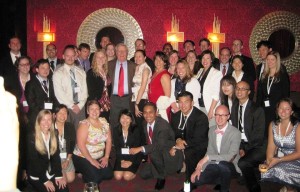
JETAA USA National Conference participants in Minneapolis with former Vice President of the United States Walter Mondale, Sept. 26, 2013. (Courtesy of Yeu-Li Huang)
By Yeu-Li Huang (Yamanashi-ken, 2007-2010) for JQ magazine. Yeu-Li is the current chapter secretary of the JET Alumni Association of the Southeast (JETAASE).
MINNEAPOLIS, Minn. – The JET Alumni Association of Minnesota (JETAAMN) hosted this year’s USA National Conference from Sept. 26-29 with assistance from the Ministry of Foreign Affairs (MOFA) and the Council of Local Authorities for International Relations (CLAIR). Attendees included delegates from all 19 JETAA USA chapters, as well as representatives from CLAIR, MOFA, and the Consulate General of Japan at Chicago.
Each national conference spotlights particular challenges facing the JETAA community. This year was no different, as critical topics included continuation of the JETAA national initiatives, common issues facing JETAA chapters, membership outreach, and collaboration between JETAA chapters and other Japan-related organizations.
Thursday, Sept. 26
The conference got underway with an evening reception at the restaurant Crave, featuring former Vice President of the United States Walter Mondale as a special guest. A native Minnesotan, Mondale was also the U.S. ambassador to Japan from 1993-96. In his speech, Mr. Mondale praised the work that the JET Program has done in building personal relationships between Japan and the U.S., and called for “JETers” to continue fostering those ties.
JQ Magazine: JQ&A with Producer Jeron Moore on ‘The Legend of Zelda: Symphony of the Goddesses’
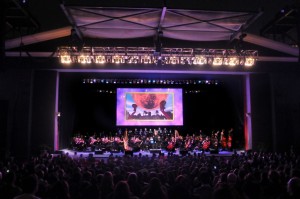
Producer Jeron Moore on Symphony of the Goddesses: “We cater to all ages. You’ve got to remember that Zelda is 27 years old now. We’re seeing fans spanning three generations buying tickets to the show.” (Andrew Craig)
By Vlad Baranenko (Saitama-ken, 2000-02) for JQ magazine. Vlad is an avid photographer.
F. Scott Fitzgerald famously said, “There are no second acts in American lives.”
Fortunately, there are Second Quests.
Over 25 years after the blockbuster Nintendo video game series first hit the scene bearing its namesake in honor of Fitzgerald’s wife, The Legend of Zelda: Symphony of the Goddesses returns for an encore run in some of North America’s most distinguished theater halls (including, for the first time, a pair of dates in Mexico). Presented by Jason Michael Paul Productions, the show—currently on tour through December—presents the very best of Zelda’s lush symphonic scores paired with a live orchestra and visual effects.
In this JQ exclusive, producer and lead creative Jeron Moore sounds off what’s new about the show, the experience of working with Nintendo to bring the ultimate live experience to fans, and the evolution of Link throughout the saga’s rich history.
What was the inspiration for this installment of the show?
Well, if you’re a Zelda aficionado, you’ll recognize the term “Second Quest” from the New Game+ mode from the original 1986 entry, The Legend of Zelda, on the NES. It’s a mode you’d unlock once you defeated the game, and what it did was reorganize the game a little bit, made the dungeons a bit harder, made the items a bit more challenging to find, made the bosses a bit more difficult to defeat. We’ve taken the idea of visiting familiar places while encountering new challenges and applied that to the Second Quest, which has been revamped to include a half hour of new material while keeping all of the classics that make The Legend of Zelda what it is.
What surprises can we expect from the Second Quest?
They wouldn’t be surprises if I told you! But I will hint that we’re celebrating the 20th anniversary of a particular, very special handheld title. We’ve also finally included some music from one of the most recent Zelda games, which we steered cleared of with the first season program. And at the request of Mr. Eiji Aonuma, you can also expect to see a fully revamped Wind Waker segment, featuring gorgeous visuals from the game’s recent HD release on the Wii U. The Wind Waker has never looked better.
How did the idea for format of the show come about? The large screen, the orchestra?
It’s simple. There’s just nothing classier than a large orchestra tuning up, then performing powerhouse symphonic interpretations of your favorite music, no matter the genre. For The Legend of Zelda, we wanted Symphony of the Goddesses to be as accessible as possible. There’s nothing worse than sitting in a room and feeling left behind because you didn’t walk in with a prerequisite knowledge of the material. The music undoubtedly stands on its own, but incorporating visuals opens it up and informs the entire audience of context, not just those who’ve played the games before. Of course, being the fans that we are, we’ve carefully edited the footage into an entertaining narrative that, we feel, makes sense. With that, we’re able to hit on many of the important moments universally adored by fans, so yeah—lots of inside jokes, but we try not to let anything fall flat.
JQ Magazine: Australia Unfolds Its 17th Japanese Film Festival
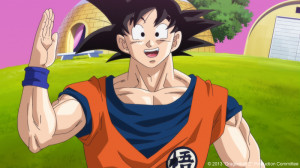
The new Dragon Ball Z: Battle of Gods hits six cities in Australia as part of its 17th Japanese Film Festival continuing in October through December. (Dragon Ball Z Production Committee)
By Eden Law (Fukushima-ken, 2010-11). After the JET Programme more than fulfilled its promise of “an experience of a lifetime,” Eden returned to Sydney, Australia, where he joined the JETAA New South Wales chapter to take advantage of the network and connections available to undertake projects such as an uchiwa design competition for the Sydney Japan Festival. He also maintains the JETAANSW website and social media. Other than that, he’s a web designer and a poet, gentlemen and raconteur.
Like a springtime wave of hanami Down Under, the 17th Japanese Film Festival began showing in staggered releases nationally in Australia, blooming first in Broome in late September, before displaying a full bouquet of film delights in the major metropolitan areas of Sydney and Melbourne. This is the first time that the festival has launched a national program, ranging from a mini ensemble of three films for small towns like Broome and Cairns, to a behemoth 33 new films and five classics in major cities like Melbourne and Sydney, which means the festival will run from 17 Sep to 8 Dec as it tours around Australia. Many of the new films will be shown for the first time in Australia (aw, you spoil us, Japan Foundation, you really do!). In addition, at this time of writing, the five classics will be shown for free, allowing even the most penniless hipster to get a gander and drop a casual mention at the right fashionable dinner parties.
With so many new films, many of which aren’t known outside of Japan (trust me, I’ve Googled this), how will you know which to watch and be informed like the sophisticate that you no doubt are? Well, for a start, check out the screening schedules for all the films in your (nearest) city. But fret not, gentle reader, for I shall explore some of the selections on show.
Based on a True Story
Documentaries and dramatisations based on true stories feature strongly in this year’s program. A Boy Called H, which won Special Prize at the Moscow International Film Festival 2013, is based on Kappa Senoh’s best-selling autobiography about growing up in World War II-era Kobe. Closing some of the larger programs, Fruits of Faith is based on a novel inspired by a true story of a fruit grower who tries to achieve the impossible dream of the perfect crop of organic apples, despite skepticism and threat of bankruptcy. Reunion, based on a journalist’s accounts, is an illustration of how individuals strive to retain their humanity and compassion in the face of unrelenting misery and death in the wake of the Tohoku disaster. Leaving no eye dry at last year’s Montreal Film Festival, it’s a good way to see if life has yet to crush all feelings out of your bitter husk. And for anyone who has ever treasured a truly good bowl of ramen (especially after a long night of clubbing in Tokyo—the Japanese equivalent to our 4 a.m. kebab), the documentary The God of Ramen will inspire not just food lovers, but anyone who’s ever had an all-consuming (hah!) passion.

